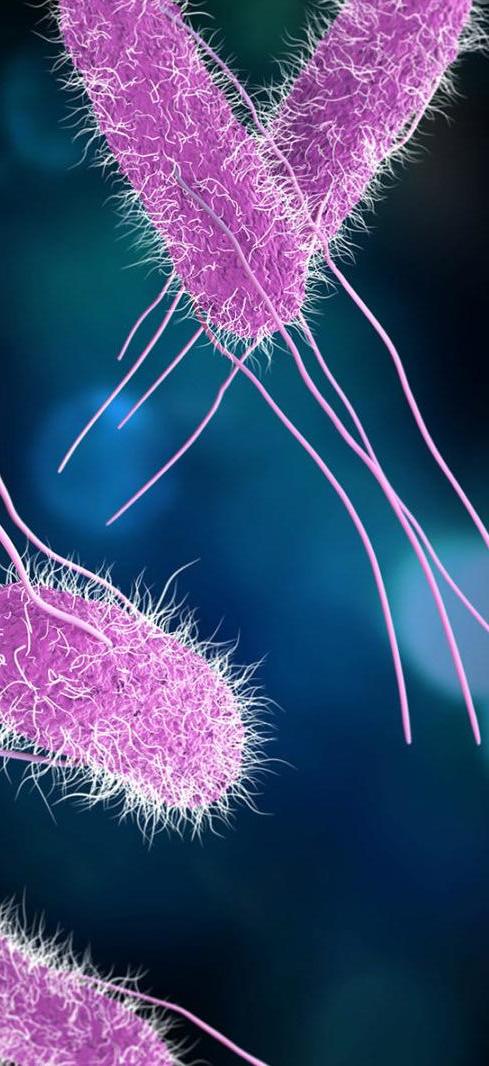
4 minute read
Feature: Salmonella explained
from Bottom Line Oct2020
by Foodbuy
Food safety
SALMONELLA EXPLAINED
The bacteria Salmonella often hits news headlines for causing severe food poisoning outbreaks. Most recently, outbreaks have been linked to red onions and peaches, both imported from the U.S. Usually, about 6,000-12,000 cases of Salmonella are reported each year in Canada, and thousands more are not reported.
WHAT IS SALMONELLA
Salmonella is a group of bacteria that commonly cause a foodborne illness called salmonellosis. You can’t see, smell or taste it. Most people who get infected with Salmonella get the bacteria from contaminated food or water. Contamination typically happens after infected feces comes into contact with animals, crops or water and people then consume or touch those items and don’t wash their hands. Humans and animals typically have some Salmonella bacteria in their stomach and intestines, but stomach acid and intestinal bacteria generally kill the Salmonella before it has the opportunity to invade cells and replicate. Or, the Salmonella simply exit the digestive tract before it causes problems.
WHO’S MORE AT RISK?
Children, especially those under 5, are more likely than adults to get sick from salmonella. Older adults and people with weak immune systems are also more likely to be infected. Other risk factors include: • International travel: Salmonella is more common in places with poor sanitation. • Taking certain drugs: Cancer drugs or steroids can weaken your immune system. Antacids lower how much acid is in your stomach, which makes it easier for salmonella to survive there. Antibiotics can kill “good” bacteria in your body and make an infection harder to fight. • Inflammatory bowel disease: This can damage the lining of your intestines, making it easier for salmonella to take hold.
SYMPTOMS
Symptoms typically start 6 to 72 hours after exposure to Salmonella bacteria and usually last 4 to 7 days • fever • chills • diarrhea and/or bloody stools • abdominal cramps • headache • nausea and/or vomiting People who are infected with Salmonella bacteria can be infectious from several days to several weeks.
TREATMENT
In healthy people, salmonellosis often clears up without treatment, but sometimes antibiotics may be required. You can also become dehydrated if you don’t get enough fluids to replace what you lose because of diarrhea. In some cases, severe illness may occur and hospitalization may be required. People who experience symptoms, or who have underlying medical conditions, should contact their health care provider if they suspect they have a Salmonella infection.

SALMONELLA CULPRITS
The types of food most often involved in salmonella outbreaks are raw or undercooked products from animal sources, such as beef, poultry and eggs. Fruits and vegetables such as alfalfa and bean sprouts, romaine lettuce, cantaloupe, and tomatoes have also been associated with salmonella outbreaks. In addition, there have been cases of salmonellosis associated with unpasteurized fruit juice and cider, and unpasteurized dairy products. Salmonella contamination is not limited to these food items. Any food can become contaminated with salmonella.
LEAF INVASION
Researchers at the University of Delaware have discovered that wild strains of salmonella can evade a plant’s immune defenses by invading the leaves through the stomata. The invaded plant does not show any obvious signs of infection, and the pathogens cannot be simply rinsed off, which means they can easily jump to people.
Stomata are tiny pores that open when there is plenty of sunlight for photosynthesis and close at night. The pores also close upon detection of threats such as drought or microbial pathogens. But pathogens like salmonella have found a way to reopen closed stomata and gain entry to the plant.
Open stomata
CO2
Closed stomata
H2O
O2 WHY DOES LETTUCE KEEP GETTING CONTAMINATED?
Numerous outbreaks of Salmonella have been caused by lettuce and other leafy greens. Lettuce needs a lot of irrigation water during cultivation. And sometimes the problem is as simple as cross-contamination on the farm where it’s being grown.
On the farm
Salmonella can spread to lettuce and other vegetables if they are fertilized with contaminated manure or irrigated with contaminated water. The risk of contamination increases when plants are grown close to a livestock field. Contaminated fecal matter gets into the sediment, then gets into the water, which then gets irrigated onto the crops. The bacteria can also come from birds flying overhead or other wild animals walking through fields.
Raw versus cooked
It’s not just lettuce and leafy greens that get contaminated. We’ve seen cucumbers and other salad greens as sources of outbreaks too. The common link? They are rarely cooked before being consumed. Thoroughly cooking food can kill salmonella and other bacteria. So other vegetables may be getting contaminated just as lettuce is, but because the vegetables are mostly being cooked, there is no widespread outbreak of illness.
Washing it away
Washing the produce at home is not a reliable way to remove bacteria. The bacteria can be stuck on the surface of the lettuce and it can even get inside the lettuce, so washing will not removing 100% of it. Ingesting one single bacterial cell is enough to cause illness. And if you’re using pre-washed packaged vegetables, there’s still no guarantee there’s no contamination. Washing is done to remove the dirt only. And consider that the lettuce is cut and bagged in processing plants, where alot of hands and machinery are in contact with it. All of which can carry and move contamination around.
Freezing or refrigerating food will not kill salmonella, although it will stop the bacteria from reproducing. Peeling vegetables will not make fruits and vegetables safer to eat either, as the bacteria can be inside the vegetable.






